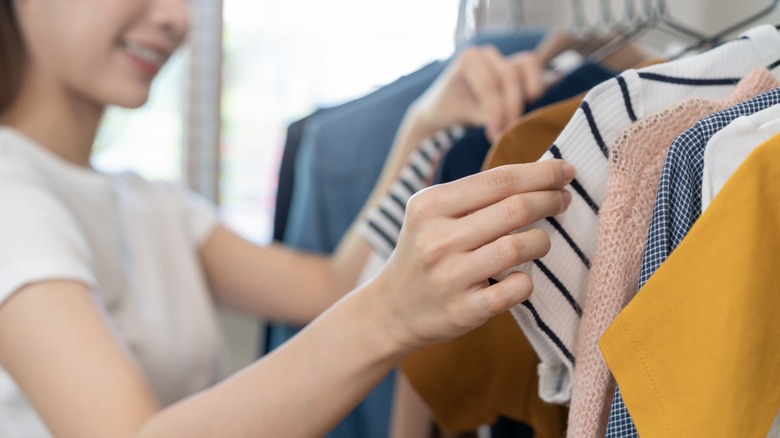What It Means To Be A Conscious Consumer
More and more people are taking steps to become a conscious consumer, aka someone who seeks to make positive environmental, economic, and social changes with their purchases.
Across social media, the concept of conscious consumerism is becoming more popular, with the viral "deinfluencing" TikTok trend only exacerbating its growth. The "deinfluencing" hashtag on TikTok has millions of views, showing that there is definitely an interest in being more of a conscious consumer. Notably, the deinfluencing movement began as a response to overconsumption by influencers but has since morphed into more of a "buy this, not that" challenge, once again promoting overconsumption. Still, there is hope that things are changing, with huge companies taking steps toward attracting the more conscious consumer. For example, Levi's is actively trying to use sustainably sourced cotton as well as less water to create their iconic jeans, whereas Patagonia offers a repair program for their products and promotes purchasing Patagonia items secondhand.
Here are five ways you can become a more conscious consumer and do your bit for the planet, no matter the financial situation you're in.
Start by thinking about what you already own
The first (and easiest) way to become a conscious consumer is to limit the amount of things you actually buy. We're all guilty of seeing the latest trends pop up on our Instagram feed or TikTok FYP and putting things in our basket — only for them to arrive, and the realization hits that you have nothing to style your new clothes with.
Of course, this doesn't include items that you actually need to replace, like a mascara you use every day or a top that has fallen apart from being worn many, many times. Instead, this change focuses on items that you see and feel the need to buy, despite knowing deep down that you don't actually need them. This idea also ties in with the idea of a "no spend month," a search term that is blowing up on TikTok and is exactly what it sounds like — a month where you buy nothing except exactly what you need. Once you start prioritizing need over want, you'll find your non-essential purchases will slowly begin to minimize themselves.
Always do your own research on a brand
In line with the above, if you do need to replace something like a T-shirt, don't just go out and buy the first one you see. Take your time to research the brand you're considering buying from and the materials used for the item to determine if it's a quality piece.
Sustainability and ethics rating website Good On You is a solid place to begin, as it has a wide catalog of brands and lists in detail the areas where they excel and where they are lacking. An important thing to keep in mind is that sustainable clothing is often more expensive, meaning it isn't in-budget for many. If this is the case for you, keep in mind that one purchase from a less sustainable brand won't cause irreparable damage to the planet — it's excessive buying and overconsumption that has a negative impact on the planet.
In line with the above tip, once you've chosen your item, think about how many items in your current wardrobe it will match with. You may like a top, but if you have to buy other items to pair with it, it probably isn't what your wardrobe needs.
Reducing temptation will help you to think more consciously
As mentioned above, being influenced to buy an item is one of the main obstacles when it comes to being a conscious consumer. We've all mindlessly scrolled when bored and stumbled across a deal that catches our eye, and the same goes for email newsletters. When you receive an email telling you about a special event or limited-time discount, the adrenaline rush can make you forget to think about your purchases mindfully.
Sales are an excellent time to purchase items you've been needing to buy for a while, but they can also be an enemy to someone trying to become a conscious consumer. Unsubscribing to newsletters will help to curb some of your impulse buying, as you won't be so aware of flash sales happening at any given time.
This also goes for returning items when you've changed your mind about an impulse buy. Often, companies send returned clothes to landfill, which produces a shocking annual 27 million tons of carbon dioxide emissions. By only buying items that fit your current wardrobe, you'll be actively helping the environment without needing to spend any money.
Choosing to go secondhand can make a big difference
Another excellent way to do your bit for the environment is by thrifting or buying secondhand. Thrifting was trendy in 2023, with the TikTok hashtag "#thrifthaul" garnering billions of views. As well as going to a physical thrift store, there are several online thrift shops to choose from, such as Thredup for regular items and TheRealReal for luxury goods.
There's no doubt that shopping secondhand can have a hugely positive environmental impact. There are also thrifting hacks for the best chance of finding higher-quality clothes. Not only are you preventing items from going to landfill, but secondhand items are usually cheaper, so thrifting is also a great option if you're on a budget.
Despite this positive impact, it's important that you only thrift what you need. A lot of thrifters can't stand Depop sellers and those who sell on other platforms like Poshmark, as they often thrift items they have no intention to wear and then resell them for a much higher price. Moreover, most clothes found in thrift stores are from fast fashion brands, caused by the rise in micro trends and the desire people have to keep up with the ever-changing next big thing in fashion. While thrifting is a good, measured alternative to shopping fast fashion firsthand, it can quickly become unsustainable if you buy more than you need.
Consider where you buy your groceries
You can reduce your footprint and become a conscious consumer in more ways than changing up where you shop for clothes. Nikki Vargas, the editor-in-chief of feminist travel publication Unearth Women, told The New York Times that she recommends keeping things local. While Vargas was referring to shopping locally when traveling, the same thing applies to everyday life. Some farmers' markets and small local shops have better deals than your nearest large grocery store, and the smaller selection will force you to think about what you consciously need.
Once again, the concept of only buying what you need comes into play here. If you see that radishes are on sale, stocking up on them may seem like a good deal. However, buying more than you need leads to food waste, which in turn leads to the waste being sent to landfill and releasing greenhouse gas emissions that are harmful to the planet.





